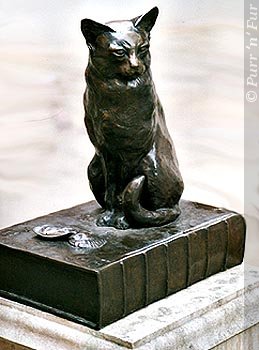

Articles in Famous Felines are written by
Patrick Roberts
Copyright © 2003-17 Purr 'n' Fur UK
Certain features on these pages use JavaScript

|

Articles in Famous Felines are written by Certain features on these pages use JavaScript |
[ Home | Famous | Featuring | Fans | Fabled | Folios | Fun | Philately | Fragments | Flotsam ]
Left-click thumbnails for enlargements (JavaScript should be enabled),
but please allow all images to load before doing so, or some may not display
(if this happens, use Refresh from your toolbar to reload the page)
|
Hodge was the treasured companion of Samuel Johnson (1709-84), who is remembered as an eighteenth-century man of letters, lexicographer — his most famous work is the Dictionary of the English Language, published in 1755 — and cat lover. Hodge loved oysters, which at the time were seen as a cheap and nutritious food rather than the luxury they have become today; and Johnson would go himself to the fish market to buy them, as he thought asking the servants to do so would make them resentful and ill disposed towards Hodge. James Boswell (1740-95) became a friend and later the biographer of Johnson, but admitted that the presence of the cat when he visited sometimes made him uneasy. He confessed to being much surprised at the 'indulgence with which [Johnson] treated Hodge'. One day, though, he suggested that, as cats go, Hodge was a very fine specimen — to which Johnson replied that he was indeed, but that he had previously had cats that he had liked better. However, he noticed that his cat seemed rather put out by this remark, so Johnson added, 'But he is a very fine cat; a very fine cat indeed.' Hence the inscription on Hodge's memorial. |

|
|
It isn't known when Hodge went to live with Johnson, but he's first mentioned in the late 1760s. The name 'Hodge' is a variation of Roger and was a traditional name for an English countryman, so possibly the cat came as a youngster from one of Johnson's many trips to the countryside at around that time. We do not know when Hodge died, but it's known that when he was near to death his master went out to obtain some valerian for him, to make his last hours as pleasant as possible. (Valerian is a plant that cats like, similar to catnip.) It is thought that he was a black cat. Little is known of Samuel Johnson's other cats, although he and his wife Elizabeth had some during their married life in London. It's suggested that the series of felines with whom he later shared his rooms gave him companionship and an outlet for his love in the isolated life of a hard-working scholar, following the early death of Elizabeth in 1752. In a letter of 1783 he mentions one called Lily as 'the white kitling now at full growth and very well behaved', so she must have been with him for a year or 18 months by then.
In early 2011 Lily was reported to be 'elderly and a bit batty', but still very much alive. She lives with the former curator of Dr Johnson's house, and her principal occupations were described as following patches of sunlight across the floor, and being worshipped by the family's twin children! Unfortunately there are now no cats in the Johnson house. Note: The poet Percival Stockdale wrote An Elegy on the Death of Dr Johnson's Favourite Cat; it's in quite flowery language, but you can find the text a little way down the page here. |
If you'd like to comment please contact me,
or drop in at our Facebook page
Return to:
Famous Felines index
Other sections:
Featuring Felines
Fans of Felines
Fabled Felines
Feline Folios
Feline Fun
Feline Philately
Feline Fragments
Feline Flotsam
or visit the Purr 'n' Fur home page
![]()
'Catline' divider bar courtesy of CatStuff Graphics
Our featured feline at the head of the page is Simon of HMS Amethyst.
He remains the only cat ever to have been awarded the Dickin Medal for gallantry under enemy fire,
in what became known as the 'Yangtse Incident' (1949).
Read Simon's story.
Copyright © Patrick Roberts & Purr 'n' Fur UK 2003-17
All rights reserved
Images and content (whether original or used at Purr 'n' Fur with permission) may NOT be reproduced
at another website or otherwise copied or used without prior permission.
Direct linking (hotlinking) to ANY images on this site is strictly forbidden.
If you want something,
!
Page created September 2006, with later revisions and additions